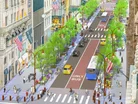How Fifth Avenue Redesign Tackles Scope 3 Emissions

New York City's iconic Fifth Avenue is undergoing a significant transformation that emphasises sustainability, pedestrian accessibility and economic revitalisation.
The redesign aims to reduce environmental impacts and highlights the city's commitment to addressing Scope 3 emissions. These indirect emissions, stemming from activities like transportation, infrastructure and supply chains, are central to the initiative.
The ambitious project, spearheaded by the Future of Fifth partnership, is poised to set a new standard for urban planning, balancing environmental goals with economic benefits.
Betsy Smith, President of the Central Park Conservancy, expresses her enthusiasm about the project's potential: "Fifth Avenue has a proud history as one of the most iconic boulevards in the world and, with this investment, its future will be just as bright."
The transformation is not just about beautifying the avenue; it is about creating a model for sustainable urban development that cities worldwide can emulate.
Scope 3 emissions and the role of urban design
The redesign of Fifth Avenue takes a strategic approach to Scope 3 emissions, focusing on reducing indirect emissions associated with transportation and infrastructure.
A key change is the reduction of vehicular lanes from five to three, which will significantly decrease traffic congestion.
Additionally, sidewalk space will nearly double, promoting walking and cycling and encouraging low-emission transportation. During peak times, as many as 23,000 pedestrians use Fifth Avenue each hour, making this shift in design a crucial step toward reducing the reliance on cars, which in turn lowers fuel consumption and emissions.
A standout feature of the redesign is the integration of extensive green spaces, with more than 200 new trees and additional plantings set to line the avenue. These green spaces serve multiple purposes, improving air quality, enhancing aesthetics and contributing to carbon sequestration.
The project includes upgrades to underground infrastructure, such as sewer and water mains, improving efficiency and reducing emissions associated with maintenance and repairs. The holistic approach aligns with Scope 3 goals by addressing emissions across the entire infrastructure lifecycle.
Economic growth and environmental benefits
New York City Mayor Eric Adams has highlighted Fifth Avenue's economic importance, noting that it supports more than 300,000 jobs and generates US$44bn in wages annually.
The redesign, expected to pay for itself within five years through increased property and sales tax revenues, promises significant economic benefits.
By creating a more vibrant and walkable space, the project reduces the need for sprawling development, concentrating activity in a more sustainable urban core. The approach supports economic growth and cuts down on the environmental costs of urban sprawl.
The Future of Fifth partnership is a collaboration between public agencies, such as NYC Parks and private entities, like the Central Park Conservancy. The public-private partnership ensures sustainability measures are embedded in both the project's design and execution.
Andrew Kimball, President of the NYC Economic Development Corporation, notes: "We have seen the economic benefits—from creating jobs to increased real estate sales—when we prioritise pedestrians in our commercial corridors."
The collaboration is an excellent example of how public-private efforts can significantly reduce Scope 3 emissions.
Social and cultural impacts
Beyond its environmental and economic advantages, Fifth Avenue's transformation will have a positive social impact. Shortened crosswalks and expanded sidewalks will create safer pedestrian spaces, benefiting vulnerable populations such as children and seniors.
"The transformation will help Fifth Avenue... reach its full potential, prioritising pedestrian safety [and] enhancing green spaces."
The holistic vision reflects the city's commitment to ensuring sustainability efforts promote social equity.
New York City's redesign of Fifth Avenue demonstrates how urban planning can address Scope 3 emissions while fostering economic and social growth.
By prioritising pedestrians, integrating sustainable infrastructure and leveraging public-private partnerships, the city is setting a new precedent for iconic urban spaces. As Betsy aptly put it, this project ensures that Fifth Avenue's future will shine as brightly as its storied past.
Make sure you check out the latest industry news and insights at Scope 3 Magazine and be part of the conversation at our global conference series, Sustainability LIVE and Procurement & Supply Chain LIVE.
Discover all our upcoming events and secure your tickets today. Subscribe to the Scope 3 Magazine newsletter.
Scope 3 Magazine is a BizClik brand.
- Target Sued Over DEI Initiatives and Shareholder ClaimsScope 1 2 and 3
- Nissan Expands Green Steel to cut Scope 3 EmissionsSupply Chain Sustainability
- Maersk Sustainability Reporting: Navigating Scope 3Transportation & Logistics
- SHEIN’s Scope 3 Emissions: Fast Fashion’s Carbon BurdenCircular Economy

